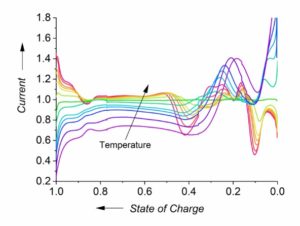Summary:
The behaviour of lithium-ion cells strongly depends on their internal temperature. Thereby, a higher temperature enhances the transport processes. An inhomogeneous temperature distri¬bution within the cell thus leads to an inhomogeneous current distribution with higher current densities in the warmer regions of the cell due to the lower resistances. As the strong interaction of temperature and current and their distribution within a cell have a high impact on performance and degradation, they are of high relevance, yet difficult to measure. There are different approaches, which all have their drawbacks. The most common method is the current measurement of the individual cells in a parallel circuit.
In this contribution, a new method is introduced to quantify the temperature influence on the current distribution. For this purpose, one commercial cell is exposed to a previously recorded voltage curve at different homogeneous temperatures and the resulting current under these conditions is measured. The homogeneous temperatures were externally imposed via self-designed cell holders. The temperature dependency of the normalized current of this cell leads to highly divergent discharge curves as shown in Figure 1. The current at the beginning of discharge is significantly higher for high temperatures due to the lower resistance. However, as the experiment proceeds, the overpotential as the driving force accumulates at low temperatures and leads to a reversal of the current curves. For a quantification of this temperature dependent behaviour, the current is evaluated for each discharge at a state of charge of 65 % and this value correlated with the temperature. Then the temperature dependency of the current distribution can be expressed with an Arrhenius-type function over a broad temperature range.
The new method is straightforward and leads to a significant improvement in terms of reproducibility. It is verified by comparing the results with those obtained from a parallel connection of three cells, in which both the influence of temperature difference and tempera¬ture level are considered. For this purpose, fresh cells of the same cell type are electrically connected in parallel, subjected to different controlled homogeneous temperatures and the respective currents are measured while the total current is applied.
In this contribution, the new method for measuring the current distribution on a single cell will be introduced, the results discussed and the mathematical correlation to quantify the temperature dependency will be presented.
We are happy to forward your request / feedback.

